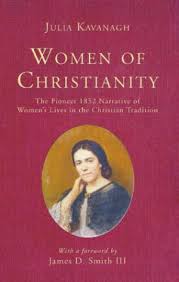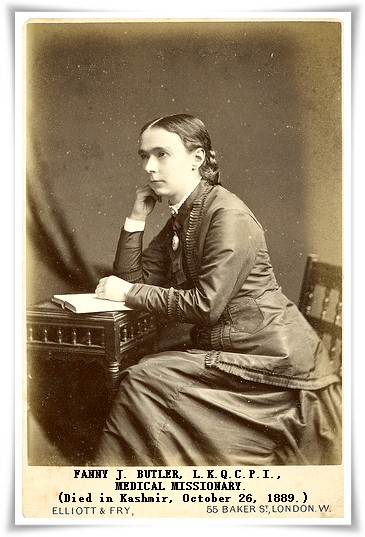
The Influence of Women
Over one hundred and fifty years ago, Irish writer Julia Kavanagh (1824-1877) noted:
“The progress of Christianity owes much, however, to these women (of the Middle Ages, ed.). .. They had little personal influence, and thus their action was not perceived at first; but the virtues of Christianity, purity, temperance, forgiveness, and resignation were essentially feminine virtues: they were more easily practiced by women than by men; and this gave to the weaker sex a moral superiority over the stronger one, which is visible even through the primitive rudeness of those dark ages.”[1]
A few years ago a well-respected pastor and author, Dr. John Piper said that Christianity has a “male flavor”. Whatever he meant by describing the Christian faith that way, countless believers interpreted it to mean that God intended for men to have the preeminence in the Church. After all, Jesus and His twelve closest disciples were all males. And of course, they say, women were only created to be submissive helpers to men.
But what should the Christian male be like? And more critically: Is it more important to be Christian or to be male? What about women? Are they lesser Christians because they are feminine instead of masculine? I contend with Julia Kavanagh that throughout the centuries and especially in the 21st century, women actually display the more Christlike characteristics and indeed Christianity has a “female flavor”.
What is wrong with putting the emphasis on males? First of all, cultural conditioning leads men to believe that they should not be emotional, share their feelings, express doubt, or show weakness. Men are asked to suppress “God-given parts of themselves that lead to human wholeness for fear it will make them less of a man.”[2]This stereotype goes against the portrait we see of Christ. Jesus displayed empathy for the lost and suffering. Jesus was able to share in the grief of others. But today’s men are not supposed to display grief at the injustice shown to others. What a shame because that is what Jesus does. Women are more like Jesus in this way.
Second, as a leader Jesus was humble and taught His disciples servant leadership. Jesus said, “But I am among you as the one who serves” (Mark 10:45; Luke 22:27). The danger in Dr. Piper’s teaching is not just in gender inequality, it is about what Jesus warned us against – selfishness, abuse of privilege, dominance, and power over others. Men who are taught hierarchical leadership are being misled. Patriarchy is not the gospel message. Jesus wants all of His followers, male and female to work together for the kingdom. So far in history, women have done the better job of displaying the Christlike characteristic of a servant.
God made men and women different. This makes the world fascinating and allows each child of God to use their abilities in unique ways. But men are wronged when they are not told that Christ modeled the characteristics of love, compassion, temperance, self-respect, endurance, gentleness, kindness, forgiveness, and empathy that we usually associate with women. Men limit the work in the Kingdom when they don’t recognize that the requirements that matter for church leadership are the same for men and women.
Jesus subverts our definition of leadership. Leadership, by biblical standards, comes from humility. True leadership picks up a towel and serves. Christ-like leaders don’t find a group of allegedly inferior beings to serve themselves. The leadership that God wants us to have is the leadership that is needed to be witnesses for Jesus. The kind of leadership can be displayed by all of Christ’s disciples, male and female.
Third, patriarchal preachers also take advantage of the fact that most men will accept their teaching when they quote from the Bible. When pastors string together Ephesians 5:21 (“wives submit to your husbands”), Titus 2:5 (wives be “subject to their own husbands”), and 1 Peter 3:1 (“wives, be submissive to your own husbands”) without adding Ephesians 5:25 (“husbands love your wives, just as Christ also loved the church and gave Himself up for her”), a distorted picture of what God says about male-female relationships emerges. Men should be told that a more beautiful picture of marriage and church is one where mutuality is taught. With all due respect, Dr. Piper’s message of male superiority is actually harmful to men and the Church as well as to women.
Fourth, the recent stories about men in church leadership positions who have abused their power have revealed that the church has not always handled moral failures well. In the wake of the #MeToo movement, women who were sexually assaulted and silenced have finally come forward for restitution. It is about time that Christians recognize the fact that men are sinners and often abuse their power in ways that Jesus never would. Women have not treated men the way that men have assumed is the correct way to treat women. Real men are like Jesus and desire to serve not subjugate. When the “male flavor” tastes like Jesus, Christians will have it right.
Julia Kavanagh must be sad as she looks down from Heaven and sees that men are still being misled as to what it means to be a Christian male. Thankfully, many men are realizing the errors in hierarchical thinking and rejecting patriarchy. There is hope yet as women and men take the gospel of peace, love, and joy to a hurting world.
[1]Julia Kavanagh. Women of Christianity, Exemplary for Acts of Piety and Charity(New York, NY: D. Appleton and Company, 1869). 55.
[2]Carolyn Custis James. Malestrom: Manhood Swept into the Currents of a Changing World. Grand Rapids, MI: Zondervan, 2015. 20.


